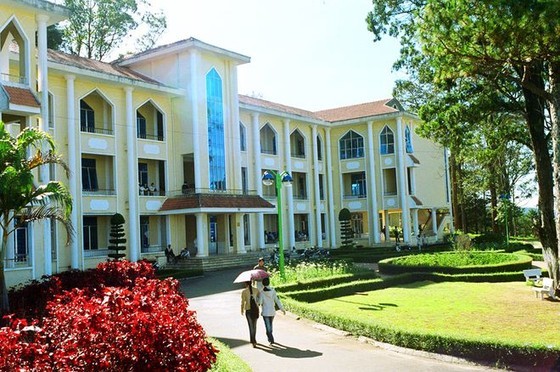 |
Da Lat University in the Central Highlands Province of Lam Dong |
The Ministry of Agriculture and Rural Development has just released a report on training and developing human resources for agriculture and rural development in the Central and Central Highlands regions for the strategy of sustainable agriculture and rural development to 2030 and a vision to 2050.
The Central and Central Highlands regions include 19 provinces and cities with a total natural area is about 54,548.3 square kilometers accounting for 16.5 percent of the country's area. The Central Highlands has become a large-scale production area for several key agricultural products, accounting for a high proportion, especially industrial crops and fruit trees.
However, the Central Highlands still has weaknesses, and the region’s development is not commensurate with its potential and advantages. Moreover, economic growth is unsustainable and tends to slow down while its GRDP per capita is still at the lowest level among the 6 socio-economic regions. Worse, the region can’t attract foreign direct investment. The Human Development Index (HDI) is the lowest in the country meanwhile education and training have not almost innovated resulting in poor quality of human resources and low labor productivity.
According to the Ministry of Agriculture and Rural Development, the above shortcomings are partly due to the lack of attention and investment in human resource development. Currently, the quality of human resources is considered the most barrier and challenge for agricultural, farmer and rural development in Vietnam and the Central and Central Highlands regions in particular.
According to a report of the Ministry of Agriculture and Rural Development, the labor force aged 15 and over in the Central Highlands in the period 2011-2021 increased from 3 million people in 2011 to 3.5 million people in 2021, an average of 2 years increased by 93,000 people because the population of the region increased steadily over the years.
The labor structure of the Central Highlands is still concentrated mainly in the field of agriculture, forestry and fishery accounting for nearly 70 percent in 2021. The proportion of trained workers in the Central Highlands has improved in the period 2011-2021 increasing from 10.9 percent to 17 percent but is still lower than the national rate.
Most of the inhabitants in the Central Highlands are ethnic minorities who are not fully aware of the importance of education, so the dropout rate is high. The Central Highlands is also the region with the lowest number of educational and vocational training institutions, universities and colleges in the country; thus, it’s little wonder that the region’s percentage of trained workers is low.
The quality of human resources for agriculture, forestry and fishery in the region is still relatively low to improve when the majority of agricultural, forestry and fishery workers in the Central Highlands are untrained workers accounting for 95.45 percent in 2020 and the proportion of trained agro-forestry-fishery workers has increased very slowly over the years only increasing from 2.62 percent in 2011 to 4.55 percent in 2020.
As of December 2022, the Central region has 4,267 agricultural cooperatives, accounting for 22.04 percent of the country while the Central Highlands has 1,488 agricultural cooperatives, accounting for 7.687 percent. However, in the Central Highlands, the proportion of cooperative leaders with university degrees is only about 44 percent, while nearly 20 percent of leaders do not have professional qualifications and the majority of workers in the cooperative have technical expertise but do not have a degree, the number of workers with a degree is less than 2 percent, much lower than the national average.
In recent times, higher education in the Central Highlands has gradually been linked and more suitable to the needs of the socio-economic development of the locality. As of 2022, nine higher education institutions and branches of universities, four pedagogical colleges and 107 vocational education institutions in the region. Amongst them, non-public institutions account for 28 percent.
Universities and colleges in the region are currently training at all levels from college to doctorate with 4 college majors, 133 undergraduate majors, 20 master's majors and 11 Ph.D. majors in agriculture, food, animal husbandry and administration and management.
However, the Central Highlands has the lowest number of university and college students in the country. The rate of university and college students is only 1.8 percent, while the Northern Midlands and Mountains – the fifth region - has 4.14 percent and the Red River Delta - the top region - has 40,9 percent. This shows that the proportion of university students in the region is still very low compared to the national average.
The Ministry of Agriculture and Rural Development supposed to create a breakthrough by training high-quality human resources, training and developing human resources in the agricultural sector to build commodity-producing agriculture based on local advantages, in association with promoting the process of research, transfer and application of science and technology to production.
For the Central Highlands region, the Ministry of Agriculture and Rural Development proposed to build high-quality training centers in Buon Ma Thuot City, Da Lat City while expanding the scale of universities and colleges. Tay Nguyen University will be a top priority in the Ministry’s proposal.
As per the Ministry, linkages and cooperation in training highly qualified human resources, industries and occupations should be strengthened to meet regional development requirements. Last but not least, the government should have policies to support students and ethnic minorities to study in boarding and part-boarding and improve the quality of civil servants, public employees and ethnic minority workers.
Following the Ministry of Agriculture and Rural Development’s goals for training and developing human resources by 2030, with a vision to 2045 for the Central and Central Highlands regions, the regions ought to strive for 70 percent of trained agricultural workers and about 80 percent of trained cooperative directors have degrees and vocational certificates according to the Prime Minister’s Decision No. 340/QD-TTg dated March 12, 2021.
The Ministry of Agriculture and Rural Development has requested higher education and vocational education institutions, and schools of agricultural and rural development managers to open new majors related to agriculture and renovate curricula with quality assurance.
Furthermore, the Ministry of Agriculture and Rural Development recommended businesses have opinions about training curricula according to their requirements; plus, businesses should support learners by granting cash for tuition fees and scholarships and awards for excellent students, especially students in agricultural majors.
The Ministry of Agriculture and Rural Development also proposed the Ministry of Finance have specific mechanisms and policies such as tuition fee exemption or reduction, increased subsidy levels, and policies to support employment after graduation to encourage agricultural apprentices.
























